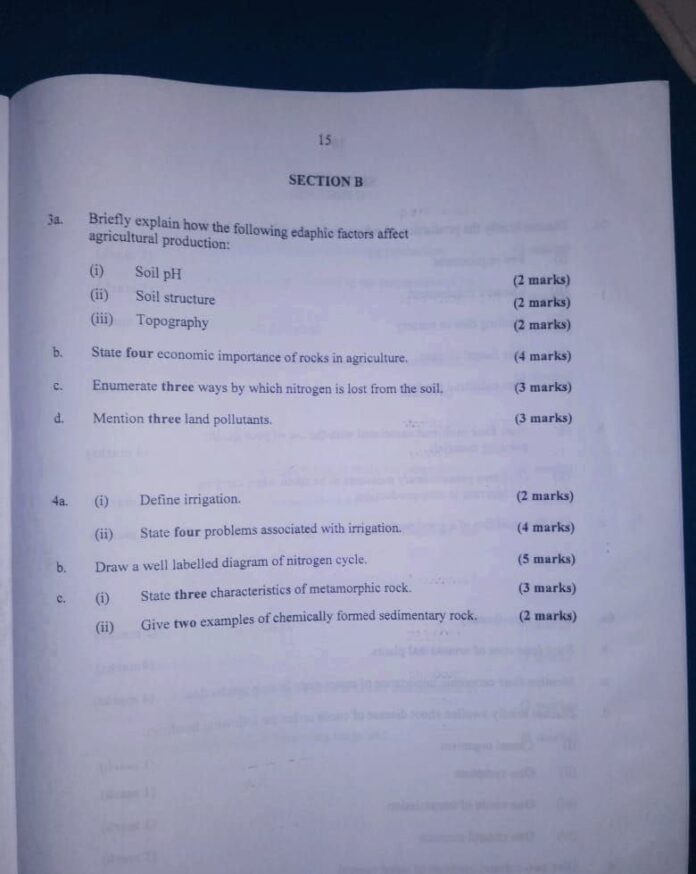NECO 2024 AGRICULTURAL SCIENCE (OBJ) OBJECTIVE ANSWERS
=====================================
AGRICULTURAL SCIENCE OBJ
01-10: CADBDBEDBA
11-20:
21-30:
31-40:
41-50:
51-60: EEDACEBDAC
COMPLETED!!! Chat me to get full answers
2024 NECO AGRICULTURAL SCIENCE (ESSAY) THEORY ANSWERS
=====================================
AGRICULTURAL SCIENCE ESSAY
NUMBER 1
(1a)
(PICK ANY FIVE)
(i) Source of Food Supply: Agriculture ensures food security for Nigeria’s growing population by providing essential food crops like yam, cassava, maize, and rice. This reduces the need for expensive food imports and stabilizes food prices.
(ii) Employment Generation: Agriculture is the largest employer of labor in Nigeria, especially in rural areas. It provides jobs across the entire value chain, from farming and processing to distribution and marketing.
(iii) Source of Raw Materials: Agriculture provides raw materials for various industries, including food processing, textiles, beverages, and pharmaceuticals. This supports industrial growth and diversifies the economy.
(iv) Foreign Exchange Earnings: The export of cash crops like cocoa, rubber, and palm oil generates significant foreign exchange earnings for Nigeria. This strengthens the country’s external reserves and supports its balance of payments.
(v) Poverty Reduction: Agriculture plays a crucial role in poverty alleviation by providing income and livelihood opportunities for millions of Nigerians, particularly in rural areas where poverty rates are high.
(vi) Revenue Generation: Agriculture contributes to government revenue through taxes, levies, and export duties. This revenue can be invested in infrastructure, education, and healthcare, further boosting economic development.
(vii) Economic Diversification: By promoting agricultural development, Nigeria can reduce its reliance on oil revenue, which is subject to price volatility. A diversified economy is more resilient to external shocks and promotes sustainable growth.
(1bi)
(PICK ANY THREE)
(i) Dynamic Agricultural Policies: The government should formulate and implement dynamic agricultural policies that recognize the contributions of peasant farmers. These policies should provide better access to essential farm inputs for all farmers.
(ii) Extension Services: Engage more extension officers to educate farmers on modern farming practices, technologies, and best practices. This will help improve the quality and output of agricultural activities.
(iii) Investment in Infrastructure: Improve rural infrastructure, including roads, electricity, and water supply. Adequate amenities are crucial for efficient agricultural production.
(iv) Financial Support: Subsidize the cost of agricultural inputs (such as machinery, seeds, and fertilizers) to make them more accessible to farmers. Additionally, ensure that loans are available at reasonable interest rates.
(v) Mass Literacy Programs: Organize literacy programs to educate farmers. Basic education is essential for understanding modern farming approaches. Demonstration farms can also be established to train farmers.
(1bii)
(PICK ANY THREE)
(i) Crop Diversification: Rather than relying on a single crop, farmers can cultivate a variety of crops that have different tolerance levels for heat, drought, or flooding. This spreads the risk and ensures that at least some crops will thrive even in adverse conditions.
(ii) Drought-Resistant and Flood-Tolerant Crop Varieties: Research and development of crop varieties specifically engineered or bred to withstand drought or flooding can be crucial. These can include native species or genetically modified organisms (GMOs) tailored to local conditions.
(iii) Improved Water Management: Efficient irrigation systems, rainwater harvesting techniques, and water-saving practices can help optimize water use during droughts and mitigate the impact of floods.
(iv) Climate-Smart Agriculture: This approach involves integrating various techniques like agroforestry (planting trees on farms), conservation agriculture (minimal soil disturbance), and precision farming (using technology for precise input application). These practices enhance soil health, conserve water, and improve resilience to climate shocks.
(v) Early Warning Systems and Climate Information Services: Providing farmers with accurate weather forecasts, climate projections, and advisories on pests and diseases can help them make informed decisions about planting, harvesting, and crop management, reducing losses due to unexpected events.
(1c)
(PICK ANY FIVE)
(i) Preserves Topsoil: Bulldozers scrape and displace the nutrient-rich topsoil, essential for plant growth. Tree pullers, on the other hand, uproot trees without significantly disturbing the topsoil layer.
(ii) Minimizes Soil Compaction: Bulldozers’ heavy weight compacts the soil, reducing its ability to hold water and air, which are crucial for root development. Tree pullers exert less pressure on the soil, minimizing compaction.
(iii) Reduces Erosion Risk: The removal of topsoil and soil compaction caused by bulldozers increase the land’s vulnerability to erosion by wind and water. Tree pullers leave the soil structure relatively intact, reducing erosion risk.
(iv) Maintains Soil Fertility: The topsoil’s organic matter content, responsible for soil fertility, is lost with bulldozing. Tree pullers help preserve this organic matter, maintaining the soil’s nutrient content.
(v) Less Environmental Impact: The fuel consumption and emissions associated with operating a bulldozer are higher than those of a tree puller, making the latter a more environmentally friendly option.
(vi) Faster and More Efficient: In areas with dense vegetation, a tree puller can often clear land faster than a bulldozer, as it doesn’t require pushing and piling debris.
(vii) Lower Operational Costs: Tree pullers generally have lower operating and maintenance costs compared to bulldozers, making them a more economical choice for land preparation.
====================
NUMBER 2
Solving/Typing…
====================
NUMBER 3
Solving/Typing…
NUMBER 4
(4ai)
Irrigation is the artificial application of water to land or soil. It is used to assist in the growing of agricultural crops, maintenance of landscapes, and revegetation of disturbed soils in dry areas and during periods of inadequate rainfall.
(4aii)
(PICK ANY FOUR)
(i) Waterlogging and Salinization: Over-irrigation can raise the water table, leading to waterlogging of the soil. This can suffocate plant roots and reduce crop yields. In arid and semi-arid regions, the evaporation of this excess water can also leave behind salts, causing soil salinization, which makes the soil unsuitable for agriculture.
(ii) Depletion of Water Resources: Irrigation often relies heavily on groundwater or surface water sources, which can be depleted over time if not managed sustainably. This can lead to environmental problems, such as the drying up of rivers and lakes, and can also threaten the livelihoods of people who depend on these water sources.
(iii) Environmental Degradation: Irrigation can alter natural ecosystems by changing water flows, soil moisture, and vegetation patterns. This can lead to the loss of biodiversity and the degradation of habitats for wildlife. Additionally, the construction of dams and canals for irrigation can have significant impacts on river systems and the surrounding environment.
(iv) Inefficient Water Use: Many irrigation systems are inefficient, losing a significant amount of water through evaporation, leaks, and runoff. This not only wastes a valuable resource but can also contribute to water scarcity and environmental problems.
(v) High Energy Consumption: Some irrigation systems, particularly those that pump water from deep underground or over long distances, can be energy-intensive. This can increase greenhouse gas emissions and contribute to climate change.
(vi) Socioeconomic Issues: Irrigation projects can sometimes lead to social and economic disparities. Large-scale projects can displace communities, disrupt traditional livelihoods, and lead to conflicts over water rights. Additionally, the benefits of irrigation may not be evenly distributed, with some farmers and communities benefiting more than others.
(4b)

(4ci)
(PICK ANY THREE)
(i) Texture: Metamorphic rocks often have a foliated or banded texture, caused by the alignment of minerals under pressure. This alignment can create distinct layers or bands, as seen in gneiss. Non-foliated metamorphic rocks like marble or quartzite have a more granular texture.
(ii) Mineral Composition: Metamorphic rocks can contain a wide variety of minerals, depending on the original rock and the conditions of metamorphism. Some common metamorphic minerals include garnet, mica, talc, and kyanite. The presence of certain minerals can be indicative of the grade of metamorphism (low, medium, or high) the rock has undergone.
(iii) Parent Rock (Protolith): The original rock from which a metamorphic rock is formed is called the protolith. For example, shale can be metamorphosed into slate, phyllite, or schist under different conditions.
(iv) Formation: Metamorphic rocks form under a variety of conditions: Regional Metamorphism, Contact Metamorphism, Hydrothermal Metamorphism, Dynamic Metamorphism.
(v) Types: Metamorphic rocks are classified based on their texture (foliated or non-foliated) and mineral composition. Some common types include: Foliated (Slate, phyllite, schist, gneiss), Non-foliated (Marble, quartzite, hornfels).
(4cii)
(PICK ANY TWO)
(i) limestone
(ii) Dolomite
(iii) Halite
(iv) Gypsum
=================
CLICK HERE TO GET FULL ANSWERS
NECO 2024 AGRICULTURAL SCIENCE ESSAY QUESTIONS





NECO 2024 AGRICULTURAL SCIENCE OBJECTIVE QUESTIONS:



 NECO JUNE/JULY AGRIC QUESTIONS AND ANSWER NOW AVAILABLE
NECO JUNE/JULY AGRIC QUESTIONS AND ANSWER NOW AVAILABLE
Recommended post:

